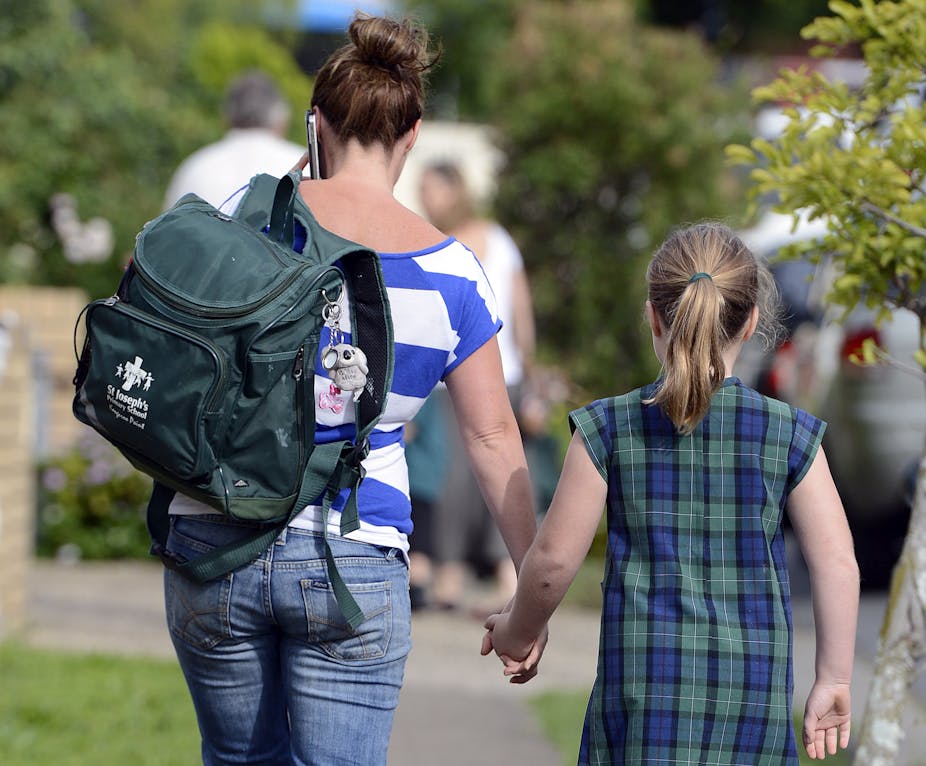Prosecuting parents for a child’s truancy is a reactive response that ignores the real issue. It turns a social problem into a criminal one, at a significant cost to schools, families and society.
Recent cases such as the prosecution of a Queensland mother for the truancy of her teenage daughter highlight this. This punishes the parent, not the child. And research shows it generally has little deterrent effect.
In addition, the prosecution of parents has very little or no justification in legal or social principle. It adds further economic, social or psychological stress to already struggling families, and to parents who either no longer have control of their children or who do not themselves see the need for education.
The federal government’s financial sanctions for parents are similarly unjustified. The policy of quarantining welfare payments to families when children do not attend school was piloted in 2010 in Queensland, introduced to the Northern Territory in 2013, and rolled out very recently in South Australia.
So, how should we as a society be addressing the truancy problem? The answer lies in creating places where young people want to go and are able to learn.
Get students involved
Prioritising inclusion, respect and engagement will help to change school culture. Students’ views can play a part in school decision-making. Respectful and responsible relationships can empower students to play a role in conflict resolution and in the creation of safe, inclusive education environments. A sense of pride can be engendered in children, returning the school to the centre of the community.
There are many reasons why students skip school, among them: fear of bullying or harassment, drug or alcohol dependency, family stress, behavioural difficulties resulting in defiance of authority, or simply boredom. Disengagement from education is a community responsibility which demands a community response.
There is increasing attention abroad to practices that embrace a wider approach. There is much evidence of their success, for example in education systems built on democratic principles in Europe, and other initiatives involving the student voice in the UK and in the US.
New Zealand’s Commissioner for Children has taken a strong role by commissioning studies of restorative practice and student participation, focusing on whole school issues.
The concept of restorative practice was developed first in the youth justice system in response to youth offending and was based on family group conferencing which encourages responsibility for actions and rebuilding relationships.
In New Zealand, this often incorporates Indigenous community inclusive processes, which apply the Maori “hui” concept to students, families, schools and communities to work together in a spirit of inclusion. These practices aim to create school environments which are cohesive and empowering for staff and students.
A few farsighted people, for example the former principal of Rozelle School in Sydney’s inner-west, Lyn Doppler, have begun similar initiatives in Australian schools. Restorative practice has been extended further to embrace student input into school decision making and classroom “circles”. In this way students learnt to relate, think and learn together.
Doppler’s research and practice confirmed that enhanced student achievement occurs in schools where these practices are embedded. It creates school environments that are inclusive, respectful and engaging. At their core is Article 12 of the International Convention on the Rights of the Child, which provides for children and young people to express their views and for them to be respected.
Other recent school initiatives in Australia include programs that allow students to plan their own maths curriculum, developing student action teams to counter bullying, and establishing student-led peer support programs.
A shared responsibility
The “right to education” is sacrosanct, as an individual right and because education is fundamental to the social and economic future of the nation.
The state is obliged to provide systems which fulfil the “four As”: accessibility, adaptability, availability and acceptability. This was set out in 2001 by the United Nations Special Rapporteur on the Right to Education, and has been adopted by education systems worldwide.
A parent’s duty is to enrol and ensure attendance of their children. This is not always easy, but it is vital, as missing even one day at school can have a detrimental effect on academic progress.
Having significant numbers of young people disengaged from education is a serious problem, both in terms of life expectations and the future of society. Being out of school substantially increases the risk of criminal offending, and a lack of education is a firm predictor of unemployment.
Truancy is a problem that cannot be ignored. However, the current solutions are not working. Those charged with the provision of public education in Australia need to give serious consideration to the need for an inclusive approach, and to provide the resources necessary to implement this, rather than putting truancy at the feet of parents, families and already overstretched public schools.

